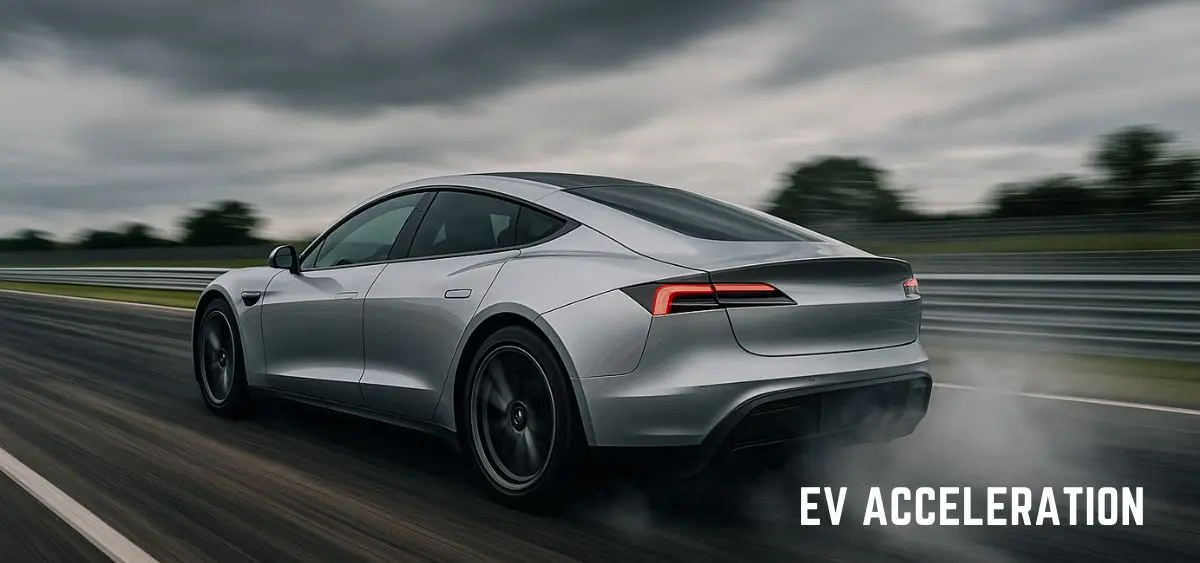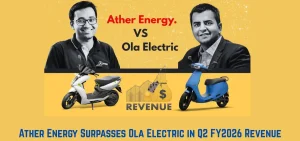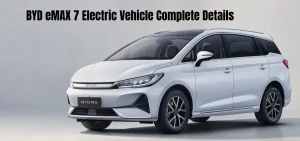Instant Torque, Instant Thrill: Why Are EVs So Quick?
When it comes to speed, electric vehicles (EVs) are shattering old stereotypes. Forget the idea that EVs are slow or boring—today’s models are built for lightning-fast performance that rivals, and often beats, their gas-powered counterparts. From Teslas launching like rockets to luxury EVs gliding from 0 to 60 in mere seconds, the world is waking up to a new era of thrilling mobility. But what exactly makes EV acceleration so powerful and unique? In this blog, we’ll dive into the science, tech, and jaw-dropping numbers behind the silent speed revolution that’s taking over the roads.
How do EVs accelerate so quickly? How Fast Are They?
Electric vehicles (EVs) are redefining speed, thanks to their instant torque and streamlined powertrain. Unlike gas engines, EVs deliver maximum torque immediately, allowing for lightning-fast acceleration. Many EVs can reach 0 to 60 mph in under 5 seconds, with some even under 3, making them quicker and more responsive than traditional cars. These factors contribute to the fast, smooth, and silent acceleration that makes electric vehicles outperform traditional gas-powered cars in terms of speed and responsiveness.
1. Instant Torque Delivery: Big Torque Instantly
One of the main reasons electric vehicles (EVs) accelerate so quickly is because of instant torque. Torque is the force that turns the wheels of a vehicle. In electric cars, this force is available immediately when you press the accelerator.
Torque Curve:
- Torque is the force that makes a vehicle move.
- In traditional Internal Combustion Engine (ICE) cars, torque builds gradually, peaking at a certain point, then dropping off.
- In Electric Vehicles (EVs), the torque curve is much different. It starts at maximum torque as soon as the motor begins spinning and maintains this peak torque for a longer period before gradually decreasing.
Why Is Instant Torque Important?
- No delay in power: Unlike petrol or diesel (ICE) vehicles that need time to build up engine speed (RPM) to reach full torque, EVs give full torque right from zero speed.
- Smooth and fast acceleration: This allows for a very quick and smooth start, often described as “linear” acceleration.
How does it work?
- In a traditional car, the engine needs to rev up, and the transmission must shift gears to deliver power.
- In an EV, the motor uses electromagnetic energy to create motion. There’s no need for gear shifting, and the power goes straight to the wheels.
- The Tesla Model S Plaid is a great example. It can go from 0 to 60 mph in about 1.99 seconds, which is faster than many supercars. This is possible because it uses three electric motors producing over 1,000 horsepower.
Constant Torque at Low Speeds:
- In ICE vehicles, torque rises and falls depending on RPM.
- In EVs, torque stays high even at low speeds, giving them a strong launch from a stop.
Better Grip and Control:
- Many EVs have motors on both the front and rear axles.
- This provides all-wheel drive, reducing wheelspin and helping deliver power more effectively.
2. Simplified Powertrain = Efficient Speed
One of the main reasons electric vehicles (EVs) are so quick is because of their simple and efficient powertrain. Unlike traditional internal combustion engine (ICE) vehicles, EVs do not need complicated systems to deliver power.
Single-Speed Transmission:
- Most EVs use a single-speed transmission, also known as a direct drive system. This means there are no gear shifts, unlike traditional cars that have automatic transmissions.
- With no gear changes, there’s no gap or interruption in acceleration. Power is delivered smoothly and continuously, resulting in quicker acceleration.
No Complex Multi-Gear Systems
- Traditional vehicles with petrol or diesel engines use multi-gear transmissions.
- These are necessary because ICE engines are efficient only within a specific range of engine speeds (RPM).
- To match different driving speeds, gear changes are needed, which can cause short delays in power delivery.
Electric Motors Work at Many Speeds
- EVs use electric motors, which can operate efficiently over a wide range of speeds.
- This means they don’t need multiple gears to perform well.
- Most EVs use a single-speed transmission or a direct-drive system, where the motor connects straight to the wheels.
Smoother Power Delivery
- Because there are no gear shifts, EVs offer continuous and smooth acceleration.
- There are no pauses or delays, which often happen in ICE vehicles when changing gears.
- This results in a faster and more consistent driving experience.
More Energy, Less Loss
- In traditional cars, energy is lost as it passes through the engine, gearbox, and other parts.
- EVs have fewer moving parts, which means less energy is wasted.
- More of the battery’s power goes directly to the wheels, improving both speed and efficiency.
3. Battery Power (More Battery = More Power)
More Battery Capacity Means More Power Output
- Electric motors can only work as fast and strongly as the battery allows.
- A larger battery can supply more current (energy flow), which helps the motor generate more power.
- This leads to better acceleration and stronger performance.
Same Motor, Different Results
- If two versions of the same EV model have the same motor but different battery sizes, the one with the larger battery often performs better.
- Why? The larger battery can handle higher energy demands without overheating or losing efficiency.
Real-World Examples
- Rimac Nevera: This high-speed EV has a 120-kWh battery that powers a 1,914-horsepower motor. It can go from 0 to 60 mph in just 1.85 seconds—and even faster (1.74 seconds) under certain testing conditions.
- Tesla Model S Plaid: With a 100-kWh battery, it also delivers incredible acceleration, reaching 60 mph in under 2 seconds.
Weight and Efficiency
- A bigger battery makes the car heavier, which can slightly reduce efficiency and may affect handling.
- However, in performance EVs, the goal is high power and speed, so the added weight is a trade-off many manufacturers accept.
Balanced Design for Power and Practical Use
- High-performance EVs aim to offer supercar-like speed while still being practical for everyday use.
- The larger battery not only gives more power but also provides a decent driving range, making the car fast and useful at the same time.
Lower Center of Gravity:
- EV battery packs are typically placed under the floor, lowering the vehicle’s center of gravity.
- A lower center of gravity improves the car’s stability and traction, which helps improve acceleration and handling.
4. No Transmission Lag
One of the biggest reasons why electric vehicles (EVs) can accelerate so quickly is that they do not use traditional multi-gear transmissions like gas-powered cars. This small difference plays a big role in how quickly power reaches the wheels.
Here’s how this works
- No Gear Shifting: In most gasoline or diesel vehicles, the engine sends power through a transmission system that includes several gears. These gears shift as the car speeds up or slows down. During gear changes, there is often a small delay where power is reduced for a moment. This delay is called transmission lag.
- Electric Motors Work Differently: EVs use electric motors that can deliver power smoothly and instantly, without needing multiple gears. Most electric cars have a single-speed transmission or a direct drive system, which means the power from the motor goes directly to the wheels without any delay.
- Instant Power Delivery: Since there is no need to shift gears, EVs do not suffer from the interruptions in acceleration that gas-powered cars do. As a result, when you press the accelerator in an EV, the car responds immediately with full torque (pulling power) available from the start.
- Smoother Driving Experience: Without gear changes, EVs also provide a smoother and quieter ride. There’s no jerking motion or waiting for the right gear. The acceleration feels natural and quick.
Why This Matters?
This simple design is a major reason why electric vehicles often feel faster and more responsive than traditional cars. Even if two cars have similar horsepower, the EV may reach higher speeds more quickly because of the absence of transmission lag. In summary, by removing complex gear systems, EVs offer faster and smoother acceleration, making them more efficient and fun to drive.
5. Lightweight Components and Their Role in EV Acceleration
Electric vehicles (EVs), especially performance-oriented models, often use lightweight materials in their construction. This plays an important role in improving how quickly they can accelerate. Here’s how:
Traction and Stability Systems:
- Electric cars also have advanced traction and stability control systems that regulate how power is distributed to the wheels.
- These systems ensure the torque is used efficiently, preventing wheel slip and maximizing traction for optimal performance.
Why Lightweight Matters?
- When a car is lighter, it takes less energy to move it.
- With reduced weight, the motor doesn’t have to work as hard to get the vehicle moving, which means faster acceleration.
- This is similar to pushing an empty cart versus a loaded one—lighter loads move quicker.
Materials Used
- EV manufacturers often use materials like aluminum, carbon fiber, and high-strength plastics to reduce overall weight.
- These materials are strong enough for safety but much lighter than traditional steel.
Better Performance
- Performance EVs, such as sports models, are designed with lightweight frames and body parts to get the best acceleration possible.
- Less weight improves not just speed, but also handling and energy efficiency.
Efficiency Boost
-
A lighter EV also uses less power from the battery, helping extend driving range slightly while boosting quick starts.
6. High Efficiency, Long Range, and Power
- A 70.0-kWh battery in an EV can allow it to travel around 250 miles, depending on driving habits and speed.
- That same amount of energy is equal to the energy found in about two gallons of gasoline.
- However, those two gallons would only take a very efficient gas car about 100 miles.
- To match the 250-mile range of an EV, a gasoline car would need nearly five gallons of fuel.
The reason for this difference is that gas engines lose a large portion of their energy, around 75%, as heat and noise. Only about 25% of the fuel’s energy is used to move the vehicle.
EVs, even high-performance ones, often maintain good driving range. While fast EVs do consume more energy, they make up for it with larger battery packs. So, even though their efficiency drops (sometimes up to 25%), they still offer long ranges.
In contrast, powerful gas cars usually have poor fuel efficiency and need larger fuel tanks to cover more distance. EVs, with their efficient use of energy, avoid this problem.
Electric Cars are the Quickest of All: EV Acceleration
- The Genesis GV60 Sport Plus can accelerate from 0 to 100 km/h in just 4.0 seconds using its boost mode—impressive for a luxury family SUV.
- However, in the EV world, this performance is fairly standard.
- The Porsche Taycan, a premium electric sedan, achieves 0-100 km/h in just 2.4 seconds.
- The Tesla Model S Plaid, another luxury EV, does it in under 2 seconds.
- Among high-performance electric hypercars:
- The Rimac Nevera reaches 100 km/h in 1.85 seconds.
- The Aspark Owl, a Japanese EV, beats that with a time of 1.69 seconds.
- The McMurtry Speirling, a British single-seater EV with 1000 bhp and massive downforce, currently holds the Goodwood Hillclimb record and accelerates from 0 to 100 km/h in just 1.5 seconds.
- In comparison, the fastest non-electric car, the Ferrari SF90 Stradale, does 0-100 km/h in 2.5 seconds, but it’s a plug-in hybrid, not a fully gasoline-powered car.
An important factor in determining an EV’s Acceleration and Top speed
1. Acceleration
- Electric motors and internal combustion engines (ICEs) both generate power to move vehicles, but their performance dynamics differ significantly.
- ICEs create motion through controlled explosions in cylinders, involving several moving parts like pistons, crankshafts, and gear systems. This results in internal resistance (friction), requiring the engine to build momentum before reaching peak torque.
- In contrast, electric motors use electromagnetic forces to generate power with fewer moving parts, allowing them to deliver maximum torque instantly, even from a standstill.
- This immediate power delivery contributes to electric vehicles’ (EVs) rapid acceleration capabilities.
- For instance, high-performance EVs like the Tesla Model S Plaid can accelerate from 0 to 60 mph in under 2 seconds, while the Rimac Nevera has set quarter-mile records, demonstrating the exceptional speed and power of electric motors.
2. Top Speed
Historically, EVs were seen as quick off the line but limited in their top-end speed. This was mainly due to their single-speed drivetrains and the natural performance limits of their motors. However, those limitations are rapidly being overcome with recent advances in EV technology.
For instance, the Genovation GXE, an all-electric version of the Chevrolet Corvette, surpassed 210 mph just a couple of years ago. Fast forward to today, and the Rimac Nevera is pushing boundaries even further, boasting a top speed claim of 258 mph. These milestones not only challenge the perception of EVs as limited-speed machines but also eliminate one of the long-standing objections to electric performance vehicles.
How is Top Speed Calculated?
The maximum speed an electric car can reach depends on how fast the electric motor can spin. Once the motor’s maximum revolutions per minute (RPM) is known, the vehicle’s top speed can be estimated using this formula:
Top Speed (mph) = (Motor RPM ÷ Gear Ratio) × Tire Circumference × (1 hr ÷ 60 min)
This formula demonstrates that to increase top speed, you either need a motor that spins faster, a more favorable gear ratio, or larger wheels.
3. The Transmission Debate: One Gear or More?
Unlike ICE vehicles that depend on multi-speed transmissions to operate efficiently across a range of speeds, electric motors are capable of delivering strong performance using just a single gear. This is largely because EV motors can rev much higher while remaining efficient.
This simplicity reduces both weight and mechanical complexity. But as electric sports and luxury cars begin to aim for ultra-high speeds, the need for more sophisticated multi-speed systems may return. Some future high-performance EVs may adopt two-speed transmissions or other advanced gear systems to extend their top-end performance without compromising efficiency or acceleration.
The Quickest EVs: 60 MPH in 3.0 Seconds or Less (Real-World Examples of EV Acceleration)
| Model | 0-60 mph Time | Horsepower | Torque | Top Speed | Quarter Mile Time | Additional Info |
|---|---|---|---|---|---|---|
| 2023 Lucid Air Touring | 3.0 Seconds | 620 hp | N/A | N/A | N/A | 425 miles of range |
| 2022 Rivian R1T | 3.0 Seconds | 835 hp | 908 lb-ft | 111 mph | N/A | All-wheel drive, rugged truck |
| 2022 Mercedes-AMG EQS | 3.0 Seconds | 751 hp | N/A | 154 mph | N/A | Dual motors at each axle |
| 2025 Hyundai Ioniq 5 N | 3.0 Seconds | 641 hp | 568 lb-ft | 163 mph | 11.1 seconds | Track-focused, high-performance |
| 2022 Audi RS e-tron GT | 2.9 Seconds | 637 hp | 612 lb-ft | 156 mph | 11.0 seconds | All-wheel drive, fast sedan |
| 2023 Mercedes-AMG EQE53 | 2.8 Seconds | 677 hp | 738 lb-ft | 146 mph | 11.2 seconds | Electric E-Class variant |
| 2024 Tesla Model 3 Performance | 2.8 Seconds | 510 hp | N/A | 164 mph | 11.0 seconds | Updated performance |
| 2024 Tesla Cybertruck Beast | 2.6 Seconds | 834 hp | 740 lb-ft | 131 mph | 11.0 seconds | Quickest pickup truck |
| 2022 Lucid Air Dream Edition Performance | 2.6 Seconds | 1111 hp | 1025 lb-ft | 173 mph | N/A | Extremely powerful, top-tier luxury |
| 2020 Tesla Model S Performance | 2.4 Seconds | 1020 hp | N/A | 163 mph | 10.6 seconds | Cheetah mode acceleration |
| 2025 Porsche Taycan Turbo GT | 1.9 Seconds | 1092 hp | 988 lb-ft | 180 mph | 9.3 seconds | Fastest EV tested by Car and Driver |
| Tata Nexon EV Max (India) | 9.9 Seconds | 143 hp | 250 Nm | 120 km/h (74 mph) | 20.0 seconds | Compact SUV, a popular Indian EV |
| Mahindra XUV400 Electric (India) | 8.3 Seconds | 150 hp | 310 Nm | 150 km/h (93 mph) | 19.0 seconds | SUV, a popular Indian electric vehicle |
| MG ZS EV (India) | 8.0 Seconds | 141 hp | 353 Nm | 140 km/h (87 mph) | 20.1 seconds | Fully electric SUV |
Related Articles:-





